light Alfa Romeo 156 2004 Owner handbook (in English)
[x] Cancel search | Manufacturer: ALFA ROMEO, Model Year: 2004, Model line: 156, Model: Alfa Romeo 156 2004Pages: 357, PDF Size: 5.04 MB
Page 145 of 357
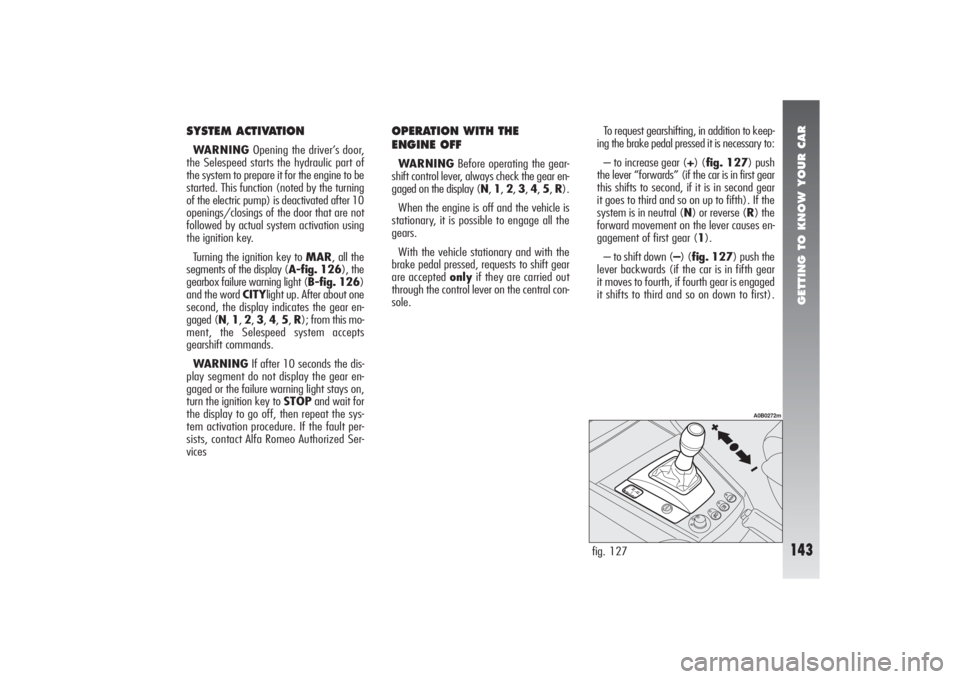
GETTING TO KNOW YOUR CAR
143
SYSTEM ACTIVATIONWARNINGOpening the driver’s door,
the Selespeed starts the hydraulic part of
the system to prepare it for the engine to be
started. This function (noted by the turning
of the electric pump) is deactivated after 10
openings/closings of the door that are not
followed by actual system activation using
the ignition key.
Turning the ignition key to MAR, all the
segments of the display (A-fig. 126), the
gearbox failure warning light (B-fig. 126)
and the word CITYlight up. After about one
second, the display indicates the gear en-
gaged (N, 1, 2, 3, 4, 5, R); from this mo-
ment, the Selespeed system accepts
gearshift commands.
WARNINGIf after 10 seconds the dis-
play segment do not display the gear en-
gaged or the failure warning light stays on,
turn the ignition key to STOPand wait for
the display to go off, then repeat the sys-
tem activation procedure. If the fault per-
sists, contact Alfa Romeo Authorized Ser-
vices
OPERATION WITH THE
ENGINE OFFWARNINGBefore operating the gear-
shift control lever, always check the gear en-
gaged on the display (N, 1, 2, 3, 4, 5, R).
When the engine is off and the vehicle is
stationary, it is possible to engage all the
gears.
With the vehicle stationary and with the
brake pedal pressed, requests to shift gear
are accepted onlyif they are carried out
through the control lever on the central con-
sole.To request gearshifting, in addition to keep-
ing the brake pedal pressed it is necessary to:
– to increase gear (+) (fig. 127) push
the lever “forwards” (if the car is in first gear
this shifts to second, if it is in second gear
it goes to third and so on up to fifth). If the
system is in neutral (N) or reverse (R) the
forward movement on the lever causes en-
gagement of first gear (1).
– to shift down (–) (fig. 127) push the
lever backwards (if the car is in fifth gear
it moves to fourth, if fourth gear is engaged
it shifts to third and so on down to first).
fig. 127
A0B0272m
Page 152 of 357
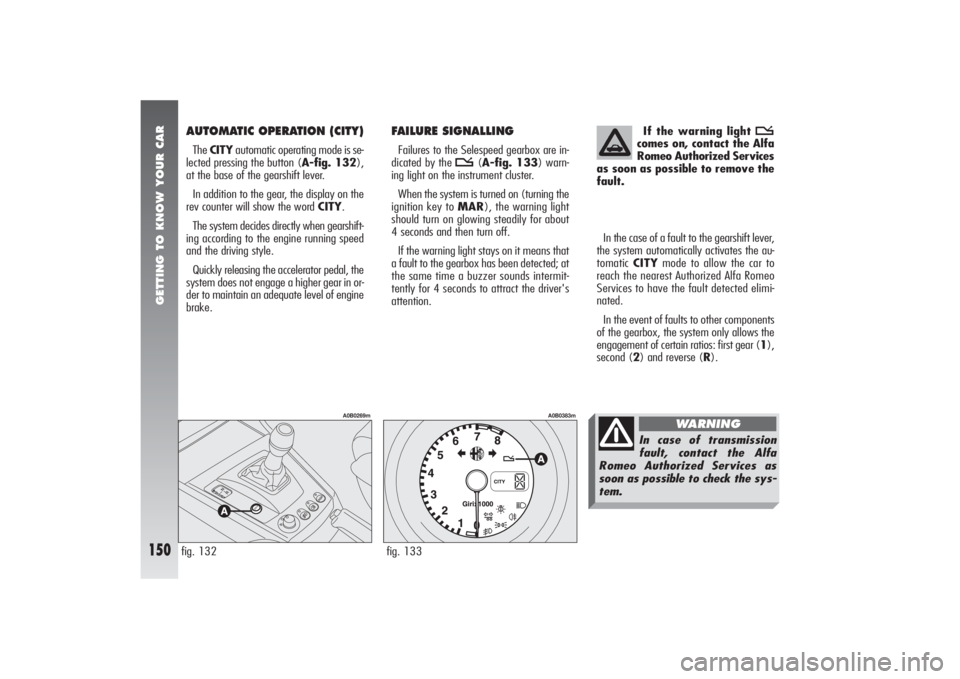
GETTING TO KNOW YOUR CAR
150
AUTOMATIC OPERATION (CITY)The CITYautomatic operating mode is se-
lected pressing the button (A-fig. 132),
at the base of the gearshift lever.
In addition to the gear, the display on the
rev counter will show the word CITY.
The system decides directly when gearshift-
ing according to the engine running speed
and the driving style.
Quickly releasing the accelerator pedal, the
system does not engage a higher gear in or-
der to maintain an adequate level of engine
brake.
FAILURE SIGNALLINGFailures to the Selespeed gearbox are in-
dicated by the
t
(A-fig. 133) warn-
ing light on the instrument cluster.
When the system is turned on (turning the
ignition key to MAR), the warning light
should turn on glowing steadily for about
4 seconds and then turn off.
If the warning light stays on it means that
a fault to the gearbox has been detected; at
the same time a buzzer sounds intermit-
tently for 4 seconds to attract the driver's
attention.In the case of a fault to the gearshift lever,
the system automatically activates the au-
tomatic CITYmode to allow the car to
reach the nearest Authorized Alfa Romeo
Services to have the fault detected elimi-
nated.
In the event of faults to other components
of the gearbox, the system only allows the
engagement of certain ratios: first gear (1),
second (2) and reverse (R).
fig. 132
A0B0269m
fig. 133
A0B0383m
If the warning light
t
comes on, contact the Alfa
Romeo Authorized Services
as soon as possible to remove the
fault.In case of transmission
fault, contact the Alfa
Romeo Authorized Services as
soon as possible to check the sys-
tem.
WARNING
Page 156 of 357

GETTING TO KNOW YOUR CAR
154
R - Reverse
Move the gearshift lever to Rwith the car
stationary, the engine idling and the brake
pedal pressed.
To prevent accidental engagements, mov-
ing the lever to this position is only allowed
raising the ring (A-fig. 138) placed un-
der the gearshift lever knob.
With the lever in position R the reversing
lights turn on and a beep is sounded for
safety reasons to indicate that reverse gear
has been engaged.
Before moving the lever, press the brake
pedal: the car must be stationary.
WARNINGWith the lever in position R,
reverse gear is not engaged if the vehicle
speed is above the established level. When
the car speed falls below this level, reverse
gear is engaged and remains engaged even
if the speed returns above the limit.
AUTOMATIC OPERATIONSelector lever
For automatic gearshifting, move the
gearshift lever to the right sector
(fig. 138) in one of the following posi-
tions:
P- park (the engine can be started)
R- reverse
N- neutral (the engine can be started)
D- automatic forward gear.
Raise the ring (A-fig. 138) placed un-
der the gearshift lever knob for shifting:
– from Pto Rand vice versa
– from Nto R.P - Park
To prevent accidental engagements, mov-
ing the lever to position Pis only allowed
raising the ring (A-fig. 138) placed un-
der the gearshift lever knob.
When the car is being parked, move the
lever to this position. A device in the gear-
box will lock the driving wheels.fig. 138
A0B0265m
Always pull the hand-
brake completely before
leaving the car.
Move the gearshift lever to posi-
tion P when getting out of the car
leaving the engine running.
WARNING
Page 158 of 357
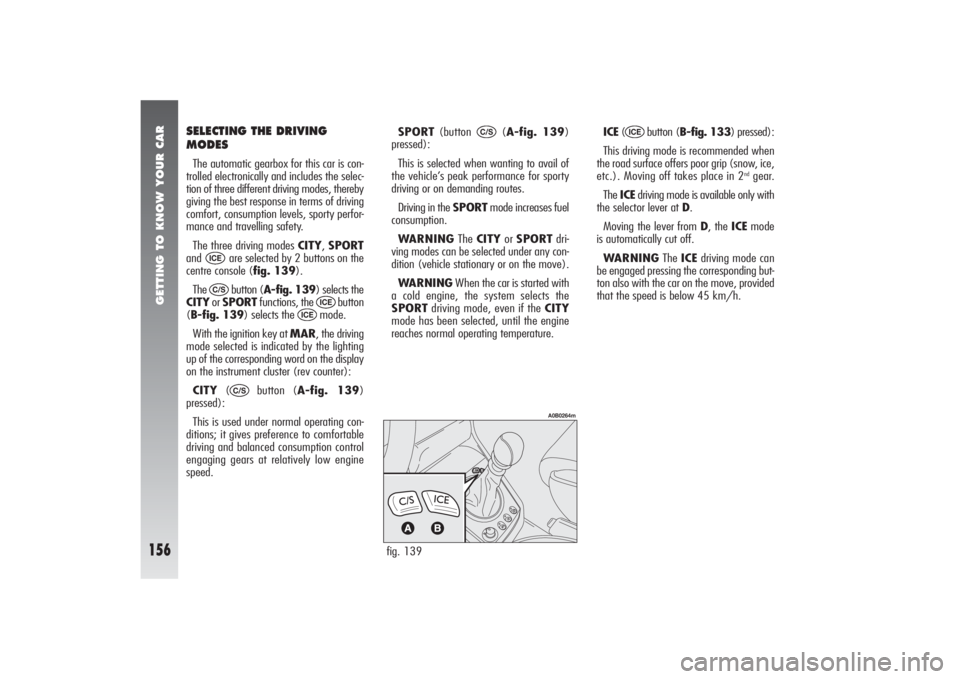
GETTING TO KNOW YOUR CAR
156
SPORT(button (A-fig. 139)
pressed):
This is selected when wanting to avail of
the vehicle’s peak performance for sporty
driving or on demanding routes.
Driving in the SPORTmode increases fuel
consumption.
WARNINGThe CITYor SPORTdri-
ving modes can be selected under any con-
dition (vehicle stationary or on the move).
WARNINGWhen the car is started with
a cold engine, the system selects the
SPORTdriving mode, even if the CITY
mode has been selected, until the engine
reaches normal operating temperature.
C/S
ICE( button (B-fig. 133) pressed):
This driving mode is recommended when
the road surface offers poor grip (snow, ice,
etc.). Moving off takes place in 2
ndgear.
The ICEdriving mode is available only with
the selector lever at D.
Moving the lever from D, the ICEmode
is automatically cut off.
WARNINGThe ICEdriving mode can
be engaged pressing the corresponding but-
ton also with the car on the move, provided
that the speed is below 45 km/h.
ICE
SELECTING THE DRIVING
MODESThe automatic gearbox for this car is con-
trolled electronically and includes the selec-
tion of three different driving modes, thereby
giving the best response in terms of driving
comfort, consumption levels, sporty perfor-
mance and travelling safety.
The three driving modes CITY, SPORT
and are selected by 2 buttons on the
centre console (fig. 139).
The button (A-fig. 139) selects the
CITYor SPORTfunctions, the button
(B-fig. 139) selects the mode.
With the ignition key at MAR, the driving
mode selected is indicated by the lighting
up of the corresponding word on the display
on the instrument cluster (rev counter):
CITY( button (A-fig. 139)
pressed):
This is used under normal operating con-
ditions; it gives preference to comfortable
driving and balanced consumption control
engaging gears at relatively low engine
speed.
C/S
ICE
ICE
C/SICE
fig. 139
A0B0264m
Page 160 of 357
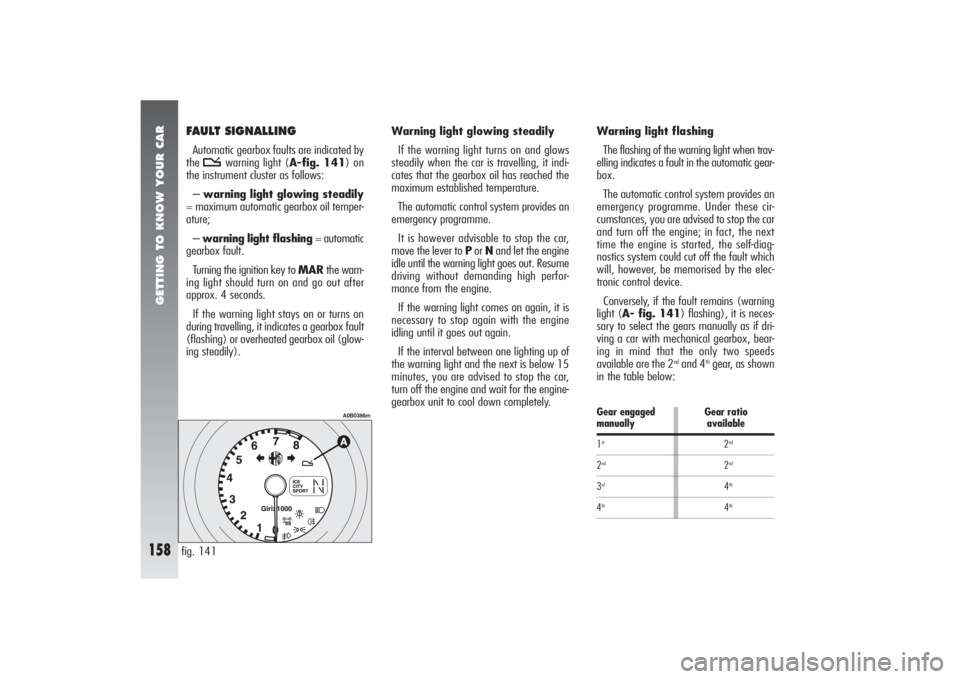
GETTING TO KNOW YOUR CAR
158
1st2nd3rd4th
2nd2nd4th4th
Gear engaged Gear ratiomanually available
FAULT SIGNALLINGAutomatic gearbox faults are indicated by
the t
warning light (A-fig. 141) on
the instrument cluster as follows:
–warning light glowing steadily
= maximum automatic gearbox oil temper-
ature;
–warning light flashing= automatic
gearbox fault.
Turning the ignition key to MARthe warn-
ing light should turn on and go out after
approx. 4 seconds.
If the warning light stays on or turns on
during travelling, it indicates a gearbox fault
(flashing) or overheated gearbox oil (glow-
ing steadily).Warning light glowing steadily
If the warning light turns on and glows
steadily when the car is travelling, it indi-
cates that the gearbox oil has reached the
maximum established temperature.
The automatic control system provides an
emergency programme.
It is however advisable to stop the car,
move the lever to Por Nand let the engine
idle until the warning light goes out. Resume
driving without demanding high perfor-
mance from the engine.
If the warning light comes on again, it is
necessary to stop again with the engine
idling until it goes out again.
If the interval between one lighting up of
the warning light and the next is below 15
minutes, you are advised to stop the car,
turn off the engine and wait for the engine-
gearbox unit to cool down completely.
fig. 141
A0B0386m
Warning light flashing
The flashing of the warning light when trav-
elling indicates a fault in the automatic gear-
box.
The automatic control system provides an
emergency programme. Under these cir-
cumstances, you are advised to stop the car
and turn off the engine; in fact, the next
time the engine is started, the self-diag-
nostics system could cut off the fault which
will, however, be memorised by the elec-
tronic control device.
Conversely, if the fault remains (warning
light (A- fig. 141) flashing), it is neces-
sary to select the gears manually as if dri-
ving a car with mechanical gearbox, bear-
ing in mind that the only two speeds
available are the 2
ndand 4
thgear, as shown
in the table below:
Page 161 of 357
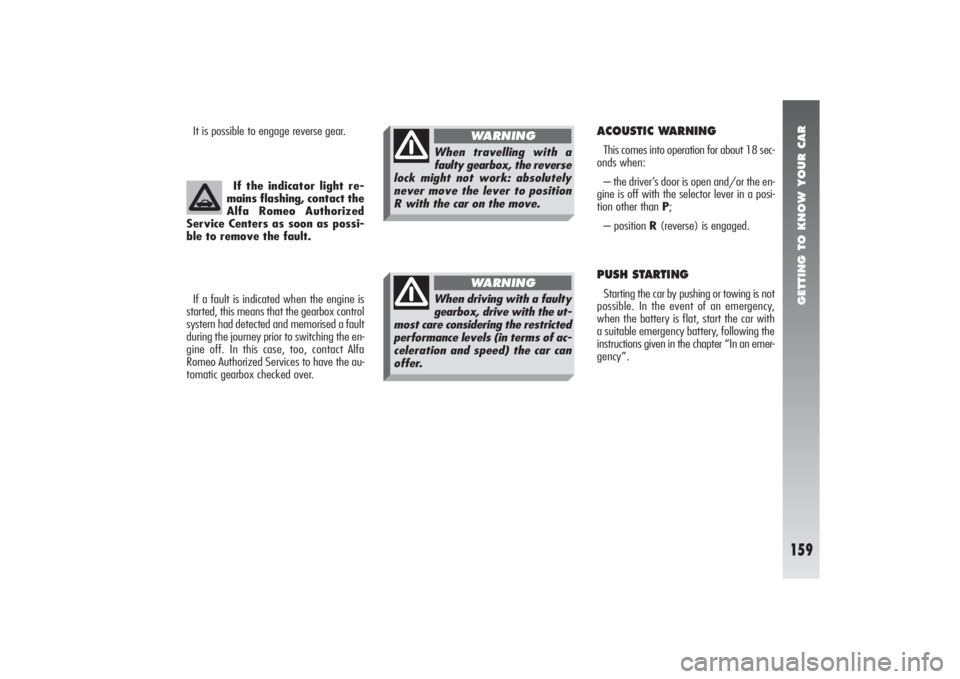
GETTING TO KNOW YOUR CAR
159
If the indicator light re-
mains flashing, contact the
Alfa Romeo Authorized
Service Centers as soon as possi-
ble to remove the fault.
If a fault is indicated when the engine is
started, this means that the gearbox control
system had detected and memorised a fault
during the journey prior to switching the en-
gine off. In this case, too, contact Alfa
Romeo Authorized Services to have the au-
tomatic gearbox checked over.It is possible to engage reverse gear.
ACOUSTIC WARNINGThis comes into operation for about 18 sec-
onds when:
– the driver’s door is open and/or the en-
gine is off with the selector lever in a posi-
tion other than P;
– position R(reverse) is engaged.PUSH STARTINGStarting the car by pushing or towing is not
possible. In the event of an emergency,
when the battery is flat, start the car with
a suitable emergency battery, following the
instructions given in the chapter “In an emer-
gency”.
When driving with a faulty
gearbox, drive with the ut-
most care considering the restricted
performance levels (in terms of ac-
celeration and speed) the car can
offer.
WARNING
When travelling with a
faulty gearbox, the reverse
lock might not work: absolutely
never move the lever to position
R with the car on the move.
WARNING
Page 163 of 357

GETTING TO KNOW YOUR CAR
161
INTERNAL FITTINGSGLOVEBOX On the dashboard there is a key glovebox
with light.The compartment is lit by a courtesy light
when it is open (when the ignition key is
at MAR(B-fig. 143).
There is a recess on the lid (C-fig. 143)
for inserting a pen or pencil. For the versions
/ markets where provided, the closure flap
is fitted with a lock. The lock can be
opened/closed using the ignition key.
GRAB HANDLES
(fig. 144)
Grab handles are set above the front doors.
Two grab handles (A) fitted with a coat
hook (B) are located above the rear doors.
fig. 142
A0B0587m
fig. 144
A0B0124m
fig. 143
A0B0261m
To open the glovebox use lever (A-
fig. 142).
Do not travel with the
glovebox open; it could
harm the passenger in the event of
an accident.
WARNING
Page 164 of 357

GETTING TO KNOW YOUR CAR
162
CEILING LIGHTS The car is fitted with passenger’s com-
partment ceiling lights (front/rear) with
gradual switching on/off. Timings, defined
as max. switching on time elapsing between
the end of gradual switching on and the start
of gradual switching off are as follows:
1)approx. 6 seconds when:
– unlocking the doors manually or by the
remote control
– closing the driver’s door to get into the
car and fit the key into the ignition switch
– removing the key from the ignition
switch.
2)approx. 3 minutes from the door open-
ing.WARNING With ignition key at STOP
or when opening a door or the tailgate 15
minutes timing is activated, then ceiling
lights go off. Timing restarts each time a
door/tailgate is opened.
Front roof light (fig. 145)
The roof light comprises two lights with the
control switch.
With switch (A) in the central position
(1), both lights turn on when a door is
opened.
When the doors are closed, a timer is ac-
tivated for about 7 seconds, to allow the car
to be started. The lights go out when the ig-
nition key is turned to MAR(with the doors
closed).
Moving switch (A) to the left (position 0),
the lights stay off (position OFF).Moving switch (A) to the right (posi-
tion2) both lights stay on.
The spot function is operated by switch
(B).
Moving switch (B) to the left (position 1)
the left spot light turns on. Moving switch
to the right (position 2) the right spot light
turns on.
With switch (B) in the central position (po-
sition 0) the spotlights stay off.
WARNINGBefore leaving the car, make
sure that both switches are in the central po-
sition. This way, the roof lights will go out
when the doors are closed. If a door is left
open, the lights will go out automatically af-
ter a few seconds.
To turn them on again, simply open an-
other door or close the same one and open
it again.fig. 145
A0B0575m
Page 165 of 357
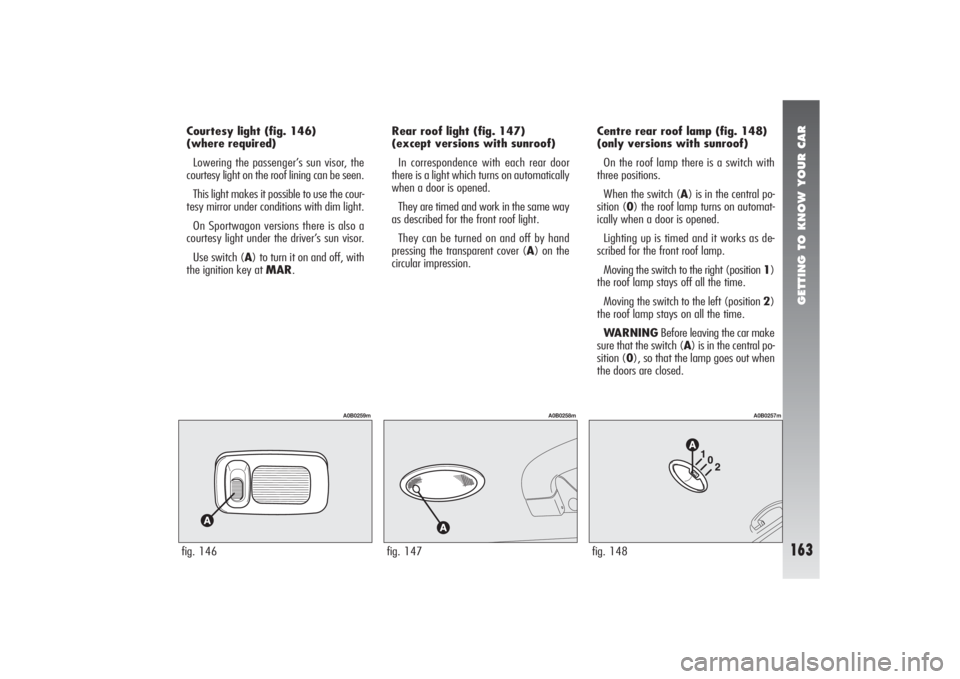
GETTING TO KNOW YOUR CAR
163
fig. 146
A0B0259m
Courtesy light (fig. 146)
(where required)
Lowering the passenger’s sun visor, the
courtesy light on the roof lining can be seen.
This light makes it possible to use the cour-
tesy mirror under conditions with dim light.
On Sportwagon versions there is also a
courtesy light under the driver’s sun visor.
Use switch (A) to turn it on and off, with
the ignition key at MAR.Rear roof light (fig. 147)
(except versions with sunroof)
In correspondence with each rear door
there is a light which turns on automatically
when a door is opened.
They are timed and work in the same way
as described for the front roof light.
They can be turned on and off by hand
pressing the transparent cover (A) on the
circular impression.Centre rear roof lamp (fig. 148)
(only versions with sunroof)
On the roof lamp there is a switch with
three positions.
When the switch (A) is in the central po-
sition (0) the roof lamp turns on automat-
ically when a door is opened.
Lighting up is timed and it works as de-
scribed for the front roof lamp.
Moving the switch to the right (position 1)
the roof lamp stays off all the time.
Moving the switch to the left (position 2)
the roof lamp stays on all the time.
WARNINGBefore leaving the car make
sure that the switch (A) is in the central po-
sition (0), so that the lamp goes out when
the doors are closed.
fig. 147
A0B0258m
fig. 148
A0B0257m
Page 166 of 357

GETTING TO KNOW YOUR CAR
164
REAR ASHTRAYS
(fig. 150)
An ashtray (A) is fitted to each rear door.
To open, pull downwards as shown below.
fig. 150
A0B0255m
FRONT ASHTRAY AND CIGAR
LIGHTER
(fig. 149)
To open the ashtray push and release the
front of the ashtray.
To use the cigar lighter press, with the ig-
nition key at MAR, button (B); after some
seconds the knob will return automatically
to its initial position and the cigar lighter is
ready for use.
Remove the tray (A) to empty and clean
the ashtray.Always ensure that the
cigar lighter has turned off.
fig. 149
A0B0256m
The cigar lighter gets ex-
tremely hot. Handle with
care and prevent its use by children:
danger of fire and/or burning.
WARNING
Do not use the ashtray as
paper bin: it could set on
fire on contact with cigarette stubs.
WARNING